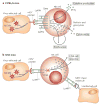Evolutionary struggles between NK cells and viruses
- PMID: 18340344
- PMCID: PMC2584366
- DOI: 10.1038/nri2276
Evolutionary struggles between NK cells and viruses
Abstract
Natural killer (NK) cells are well recognized for their ability to provide a first line of defence against viral pathogens and they are increasingly being implicated in immune responses against certain bacterial and parasitic infections. Reciprocally, viruses have devised numerous strategies to evade the activation of NK cells and have influenced the evolution of NK-cell receptors and their ligands. NK cells contribute to host defence by their ability to rapidly secrete cytokines and chemokines, as well as to directly kill infected host cells. In addition to their participation in the immediate innate immune response against infection, interactions between NK cells and dendritic cells shape the nature of the subsequent adaptive immune response to pathogens.
Figures



References
-
- Lanier LL. NK cell recognition. Anna Rev Immunol. 2005;23:225–274. - PubMed
-
- Fehniger TA, et al. Acquisition of murine NK cell cytotoxicity requires the translation of a pre-existing pool of granzyme B and perforin mRNAs. Immunity. 2007;26:798–811. - PubMed
-
- Welsh RM, Vargas-Cortes M. In: The Natural Killer Cell. Lewis CE, McGee JOD, editors. IRL Press; Oxford. UK: 1992. pp. 108–150.
-
- Lodoen MB, Lanier LL. Viral modulation of NK cell immunity. Nature Rev Microbiol. 2005;3:59–69. - PubMed
Publication types
MeSH terms
Grants and funding
LinkOut - more resources
Full Text Sources
Other Literature Sources

